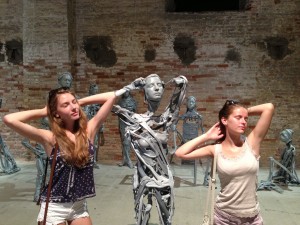
Daughter Emma and niece Carla pose among Pawel Althamers "Venetians" in the Arsenale
A summer blog: The 55th Venice Art Biennale for kids.
VENICE - A limbless, giant, pink, pregnant woman perched on the lagoon greets us on our way into town. My children are not sure if they find Marc Quinn’s 11-metre-high statue - a variation of his 'Alison Lapper Pregnant' - fascinating or frightening. (They are not the only ones: http://www.theguardian.com/artanddesign/2013/jun/02/55th-venice-biennale-review.)
Every two years we come to the Venice Biennale with friends in August. It's a perfect family holiday: boats, pasta and modern art. When all else fails, there is always the Lido, Venice’s beach. Rule number one: The daily ice cream bills cost more than admission to the art show. A two-day pass for both Giardini and Arsenale costs 14 euros for a student. The formula to keep the kids happy is like this: art, ice cream, art, ice cream, and so on. It works every time.
The Austrian pavilion has been praised as a great attraction for kids (http://derstandard.at/1369361966744/Verwirren-und-entwirren). But the young ones don't enjoy it as much as expected. What did artist Mathias Poledna want to say with his three- minute cartoon, produced by 75 cartoonists drawing over 5,000 frames and accompanied by a soundtrack produced with a full orchestra in a studio stage in Los Angeles? It's mildly interesting to understand just how elaborate film production used to be between the wars, while America's economy suffered in the Depression. But although the little movie is charming and elegant, the kids would have had more fun watching a computer-animated production. The aesthetics of early Disney fail to satisfy. Eighty years after Bambi, the movie industry has moved on.
We fare better at Greece’s artistic statement on the financial crisis: "History Zero". Stefanos Tsivopoulos tells a tale of gain and loss in three videos which examine the relationship between man and money. My-nine-year-old son holds his breath as a lady suffering dementia fashions origami flowers out of 500- euro notes and then throws them away when she thinks they have passed their prime.
My-16-year-old daughter likes a film by Camille Henrot, who won a Silver Bear for "Grosse Fatigue". A 35-year-old French artist, she tells the history of the world in her own multimedia scrapbook style. She fits perfectly into the main exhibition, entitled "The Encyclopaedic Palace".
An attempt to tell my offspring about the fiftieth anniversary of the "Elysee Treaty", a celebration of half a century of Franco-German peace, does not prove very successful. Nor are the exhibits. France borrows the German pavilion to show Albanian artist Anri Sala. In "Ravel ravel unravel", he depicts the composer's Piano Concerto for Left Hand played by two musicians simultaneously, filmed close up, with the performers’ right hands hanging down like dead birds. My 17-year-old son, left-handed like me, has played the piano for years - but remains unmoved that the left hand finally gets to play the main tune.
The French pavilion, lent to the Germans for this Biennale, is no better for the children. My nine-year-old poses between the chairs in the Ai Weiwei installation because he did a project on the Chinese dissident artist at school. But the Germans overdo it slightly with lashings of earnest international goodwill and human rights ambitions, so it's a relief for the kids to relax in "English Magic", the British pavilion between the French and the German houses. Between the artsy French and the politically correct Germans, the eccentric English manage a higher amusement factor for the children - Jeremy Deller even includes an English tea house where they can sit and drink tea.
Deller’s pavilion also features Roman Abramovich's yacht being thrown into the sea. The Russian oligarch’s boat angered art lovers by mooring ostentatiously in front of the Giardini during the last Biennale, blocking the view. My kids are experts on the subject as we lived in Moscow for seven years. So they naturally appreciate the Russian pavilion, where conceptual artist Vadim Zhakharov has a continual stream of gold coins pouring from the roof to the ground, in front of which believers and visitors can kneel on church benches to pay their respects.
One of the highlights for the children is the new Korean pavilion. Half-hidden in the bushes next to the heavy German building, we find a creation of shining light, a modern hall of mirrors. The effects of light and dark - shallow maybe, but mesmerising - keep everyone aged between 9 and 17 entertained for a while. Other favourites include the entire Book of Genesis drawn as a cartoon by Robert Crumb; the very witty clay figures of Fischli& Weiss; and the winner of the Golden Lion of the 55th Biennale, the Angolan contribution in Palazzo Cini.
There, 36-year-old Edson Chagas has captured "Luanda. An Encyclopaedic City" in 23 stills. Copies are sold for two euros each and my older son planned to cover the walls of his bedroom with them (before he left the posters in the river taxi on the way to the railway station).
In the end, Chile’s Alfredo Jaar in the Arsenale gets the most Likes. If you wait long enough, a miniature replica of the Giardini rises from a green, swampy lagoon-like mud bath. Water flows through the pathways between the pavilions as it drains away and the trees shed slimy drops. A world has appeared - as Biennale does every two years. But shortly afterwards, mechanical hands pull everything back into the dark green waters. The gardens sink and the art vanishes.
It's time for the next ice cream.
This blog is dedicated to Lily Hoffmann-Ostenhof, who hopefully will join us again in 2015.


